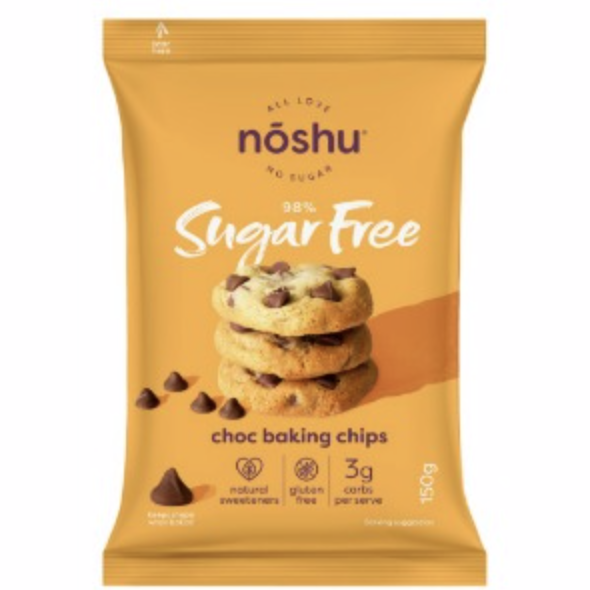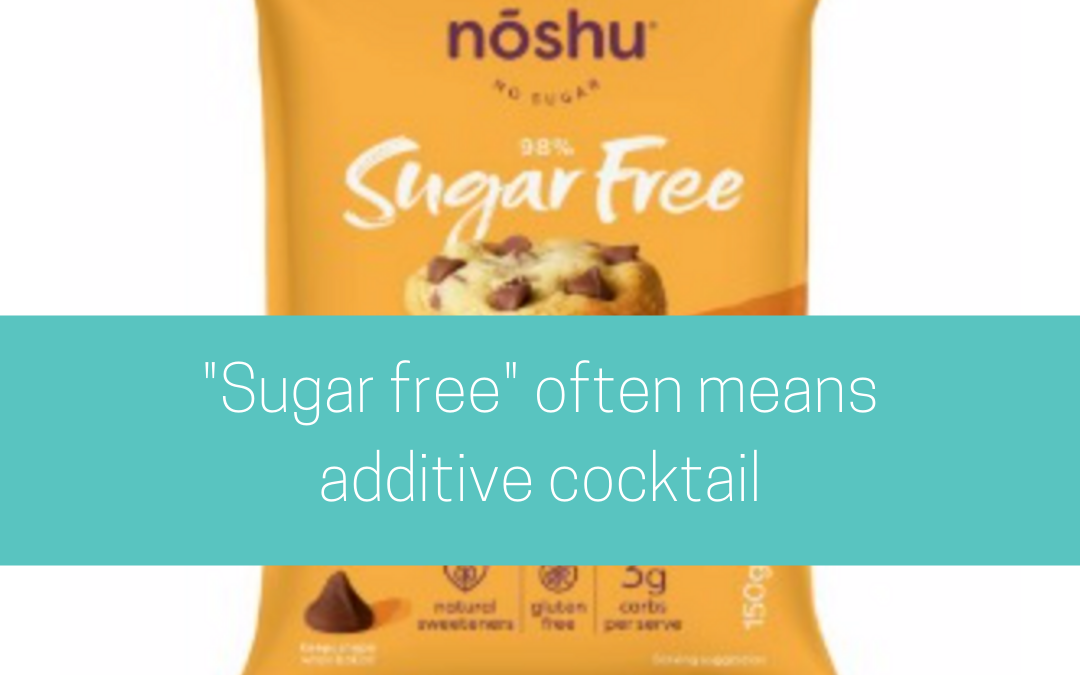The sugar free movement has really taken hold. Here in Australia, we know that Australians are consuming too much sugar with 35% of an adults total daily calories coming from discretionary foods. Examples of these discretionary foods include lollies, chocolates and soft drinks.
I don’t particularly want to enter the debate as to whether you should be sugar free or not. It is a personal choice.
However, what I do want to share, is that for those of you that are conscious about being sugar free, to check your ingredient labels. So often I see products on supermarket shelves claiming ‘sugar free’ and in its place are a cocktail of other additives.
I came across a product recently that just made me cringe. I felt that so many people are being duped by the marketing. All they see on the front of the packet is “Sugar Free” so they think the product must be better for them.
This is the recent example I came across:
Noshu 98% Sugar Free Choc Baking Chips:

Now before we take a look at their ingredients, for those that are familiar with clean eating already, you may know that you can make sugar free dark chocolate using cacao powder, cacao butter, maybe a little vanilla and salt. The ingredients can be really simple and good for you too.
Let’s take a look at the ingredients of these Sugar Free Choc Baking Chips
Vegetable fat (RSPO Certified Sustainable Palm Kernel Oil)
Malitol (non GMO)
Coconut fat (Coconut oil, maltodextrin)
Soy Protein Isolate
Cocoa powder
Natural flavours
Soy Lecithin
Stevia Leaf Extract
Analysis
So when we are looking at these ingredients, the first ingredient on the list represents the biggest proportion of this product and it decreases from there. So the Stevia Leaf Extract is used in the smallest quantity in this product.
In most other sugar free chocolates (that are chocolate), you will have cacao powder and / or cacao butter as the first ingredients.
This product is mostly made from Sustainable Palm Kernel Oil, that has been sweetened with Malitol (a sugar alcohol and sugar substitute). Other additives and ultra processed ingredients have been added to this product that you don’t normally find in chocolate.
Chocolate is usually defined as being derived from roasted and ground cacao seeds that is made in the form of a liquid, paste or in a block.
“In March 2007 the Chocolate Manufacturers Association lobbied the US Food and Drug Administration (FDA) to change the legal definition of chocolate to allow the substitution of “safe and suitable vegetable fats and oils” (including partially hydrogenated vegetable oils) for cocoa butter in additional to using ‘any sweetening agent’ (including artificial sweeteners) and milk substitutes.
Currently, the FDA does not allow a product to be referred to as chocolate if it contains any of these ingredients.
The FSANZ definition of chocolate is:
“a confectionery product that is characterised by:
(a) the presence of:
(i) cocoa bean derivatives; and
(ii) no more than 50g / kg of edible oils, other than cocoa butter or dairy fats; and
(b) preparation from a minimum of 200g / kg of cocoa bean derivatives.
I would argue that this product isn’t chocolate at all….it has a little bit of cocoa powder…but none of the typical ingredients you would find in real chocolate. I presume most of the chocolate taste is coming from the “natural flavours”.
To work around this restriction, it would appear that the manufacturers have chosen to use the word “Choc” instead of “Chocolate” So technically, this product may be legally correct. Very misleading I believe for the consumer.
Don’t fall for the front of pack claims
If you are conscious about being sugar free, please, do yourself a favour….flip the packet over….read the ingredients list. Whilst the ingredients list might not give you the 100% picture, it will give you 90-95%.
So much can be gleaned by reading this list…
Is there any point in removing sugar from your diet and replacing it with other sugar substitutes, additives and ultra processed ingredients?
We just need to get back to basics….
Back to real food.
Go get some chocolate, that is chocolate…with real ingredients…and make your choice according to which sweetener you feel is right for you. Don’t fall for a choc substitute that is made from certified sustainable palm kernel oil.
Marketing departments spend a lot of $$$$$$ to ensure that the front of pack is enticing and that you just register “Sugar Free” (in this instance). When you see the words “sugar free” this should be a warning signal to you to check the ingredients list. More often than not, the product will contain ultra processed ingredients. Not all…there are some manufacturers that making amazing sugar free products, using fruits, or maple syrup or honey etc. These will be a much better alternative for you.
Remember: flip the packet and ignore the front of pack claims!
I would love to hear your thoughts about this product. Comment below.

Frankie Bell is the Managing Director of Additive Free Kids, a food coach, mentor and is one of Australia’s leading activists against additives in foods.
Frankie is a mum to 5 boys and has personal experience working through the damaging effects of additives to resolve the multiple health issues and behavioural problems in her own children. It became Frankie’s purpose to help other families achieve the same improvements for their families.
These changes can be overwhelming, especially for time poor parents, Frankie has done all the hard work for families to ensure they have access to additive free food, anytime, anywhere. Additive Free Kids specialises in assisting families to live healthy lives free from additives. See how you can work together with Frankie here.
Join the AFK Community
If you would like to be kept up to date with the latest news, product reviews and giveaways come and join us in the Additive Free Kids Community.



 My passion and mission is to work with families to reduce the overwhelm when going additive free. Moving to additive free living can bring back peace, calm and joy to families. I know it's possible and I've experienced it first hand with my 5 boys.
My passion and mission is to work with families to reduce the overwhelm when going additive free. Moving to additive free living can bring back peace, calm and joy to families. I know it's possible and I've experienced it first hand with my 5 boys.



